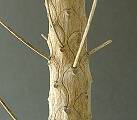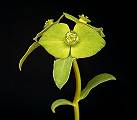|
|
Like a palm tree Euphorbia bubalina from South Africa “This one looks just like a
small palm” – I often hear this when I show this plant to friends. In its juvenile stage
E.bubalina does resemble a miniature palm tree. This pretty juvenile form can
be maintained for many years if this plant is grown ‘hard’. Small pot, plenty
of light, despite the large leaves not too much water and little fertilizer
are the right care. But E.bubalina can also be planted out if you have enough
space. At the height of approximately 30 cm it starts branching, when fully
grown it forms a loosely branched shrub. The cyathia are on stems up
to 25 cm long which turn woody after flowering and remain on the plant.
Unusual for euphorbias are the two different kinds of cyathium. The first
cyathia usually have three cyathophylls, while the following, usually three,
cyathia of the second generation have only two cyathophylls. The cyathia which occur from
February until November are bisexual and self-fertile. With their nectar they
soon attract small insects which are responsible for the pollination.
Normally all cyathia form seed “all by themselves”. |
|
|
The stems have very flat
tubercles and turn woody with age. E.bubalina is one of the few
euphorbias which should be kept cool and dry in winter. It has the tendency
not to stop growing in autumn and must be forced into dormancy by keeping it
dry, from November at the latest. If it was grown on, the shoots would turn
thin and soft from lack of light. During the winter rest, the
most recent leaves remain on the plant, while the previous year’s leaves
wither and fall off. Propagation from seed is
very easy. The occurrence of twins, that is, two seedlings per seed, is not
rare at all, and one gets usually more plants than the amount of seeds
planted. The seedlings are fast-growing and capable of flowering already in
the second year. At this time at the latest, growth should be slowed by
harsher cultivation conditions. Propagation by cuttings is
possible, but does not make much sense. Propagation by seed is much more
effective. |
|
|
|
Similar species with
comparable cultivation requirements: - E. clava: with shorter leaves and more defined tubercles - E. clandestina: with shorter leaves and stemless cyathia Sources for E. bubalina:: FR: Cacteus |
||
If you found this page without a left frame
please load www.euphorbia.de






